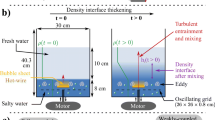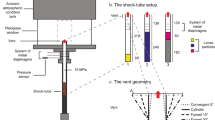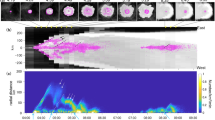Abstract
The source conditions of volcanic plumes and collapsing fountains are investigated by means of large-scale experiments. In the experiments, gas-particle jets issuing from a cylindrical conduit are forced into the atmosphere at different mass flow rates. Dense jets (high particle volumetric concentration, e.g., C 0 > 0.01) generate collapsing fountains, whose height scales with the squared exit velocity. This is consistent with Bernoulli’s equation, which is a good approximation if air entrainment is negligible. In this case, kinetic energy is transformed into potential energy without any significant loss by friction with the atmosphere. The dense collapsing fountain, on hitting the ground, generates an intense shear flow similar to a pyroclastic density current. Dilute hot jets (low particle volumetric concentration, e.g., C 0 < 0.01) dissipate their initial kinetic energy at much smaller heights than those predicted by Bernoulli’s equation. This is an indication that part of the total mechanical energy is lost by friction with the atmosphere. Significant air entrainment results in this case, leading to the formation of a buoyant column (plume) from which particles settle similarly to pyroclastic fallout. The direct measurement of entrainment coefficient in the experiments suggests that dense collapsing fountains form only when air entrainment is not significant. This is a consequence of the large density difference between the jet and the atmosphere. Cold dilute experiments result in an entrainment coefficient of about 0.06, which is typical of pure jets of fluid dynamics. Hot dilute experiments result in an entrainment coefficient of about 0.11, which is typical of thermally buoyant plumes. The entrainment coefficients obtained by experiments were used as input data in numerical simulations of fountains and plumes. A numerical model was used to solve the classic top-hat system of governing equations, which averages the field variables (e.g., column velocity and density) across the column. The maximum heights calculated with the model agree well with those observed experimentally, showing that our entrainment coefficients are compatible with a top-hat model. Dimensional analysis of the experimental data shows that a value of 3 for the source densimetric Froude number characterizes the transition between dense collapsing fountains and dilute plumes. This value delimits the source conditions (exit velocity, conduit radius, and particle volumetric concentration) for pyroclastic flow (<3) and fallout (>3).











Similar content being viewed by others
References
Andrews B, Gardner J (2009) Turbulent dynamics of the 18 May 1980 Mount St. Helens eruption column. Geology 37(10):895–898. doi:10.1130/G30168A.1
Bloomfield LJ, Kerr RC (2000) A theoretical model of a turbulent fountain. J Fluid Mech 424:197–216. doi:10.1017/S0022112000001907
Carazzo G, Kaminski E, Tait S (2006) The route to self-similarity in turbulent jets and plumes. J Fluid Mech 547:137–148. doi:10.1017/S002211200500683X
Carazzo G, Kaminski E, Tait S (2008) On the dynamics of volcanic columns: a comparison of field data with a new model of negatively buoyant jets. J Volcanol Geotherm Res 178:94–103. doi:10.1016/j.jvolgeores.2008.01.002
Carazzo G, Kaminski E, Tait S (2010) The rise and fall of turbulent fountains: a new model for improved quantitative predictions. J Fluid Mech 657:265–284. doi:10.1017/S002211201000145X
Cioni R, Marianelli P, Santacroce R, Sbrana A (2000) Plinian and subplinian eruptions. In: Sigurdsson H (ed) Encyclopedia of volcanoes. Academic, New York, pp 477–494
Costa A, Macedonio G, Folch A (2006) A three-dimensional Eulerian model for transport and deposition of volcanic ashes. Earth Planet Sci Lett 241:634–647. doi:10.1016/j.epsl.2005.11.010
Degruyter W, Bonadonna C (2013) Impact of wind on the condition for column collapse of volcanic plumes. Earth Planet Sci Lett 377–378:218–226. doi:10.1016/j.epsl.2013.06.041
Dellino P, Zimanowski B, Büttner R, La Volpe L, Mele D, Sulpizio R (2007) Large-scale experiments on the mechanics of pyroclastic flows: design, engineering, and first results. J Geophys Res 112, B04202. doi:10.1029/2006JB004313
Dellino P, Dioguardi F, Zimanowski B, Büttner R, Mele D, La Volpe L, Sulpizio R, Doronzo DM, Sonder I, Bonasia R, Calvari S, Marotta E (2010) Conduit flow experiments help constraining the regime of explosive eruptions. J Geophys Res 115, B04204. doi:10.1029/2009JB006781
Dioguardi F, Dellino P, de Lorenzo S (2013) Integration of large-scale experiments and numerical simulations for the calibration of friction laws in volcanic conduit flows. J Volcanol Geotherm Res 250:75–90. doi:10.1016/j.jvolgeores.2012.09.011
Fischer HB, List EJ, Koh RCY, Imberger J, Brooks NH (1979) Mixing in inland and coastal waters. Academic, New York
Formenti Y, Druitt TH, Kelfoun K (2003) Characterization of the 1997 Vulcanian explosions of Soufrière Hills Volcano, Montserrat, by video analysis. Bull Volcanol 65:587–605. doi:10.1007/s00445-003-0288-8
Isaia R, D’Antonio M, Dell’Erba F, Di Vito M, Orsi G (2004) The Astroni volcano: the only example of closely spaced eruptions in the same vent area during the recent history of the Campi Flegrei caldera (Italy). J Volcanol Geotherm Res 133:171–192. doi:10.1016/S0377-0273(03)00397-4
Kaminski E, Tait S, Carazzo G (2005) Turbulent entrainment in jets with arbitrary buoyancy. J Fluid Mech 526:361–376. doi:10.1017/S0022112004003209
Kaye NB, Hunt GR (2006) Weak fountains. J Fluid Mech 558:319–328. doi:10.1017/S0022112006000383
Koyaguchi T, Woods AW (1996) On the formation of eruption columns and pyroclastic flow generations. J Geophys Res 101(B3):5561–5574
Koyaguchi T, Suzuki YJ, Kozono T (2010) Effects of the crater on eruption column dynamics. J Geophys Res 115, B07205. doi:10.1029/2009JB007146
Lin W, Armfield SW (2000) Direct simulation of weak axisymmetric fountains in a homogeneous fluid. J Fluid Mech 403:67–88. doi:10.1017/S0022112099006953
Lin W, Armfield SW (2008) Onset of entrainment in transitional round fountains. Int J Heat Mass Transfer 51:5226–5237. doi:10.1016/j.ijheatmasstransfer.2008.02.047
McDougall TJ (1981) Negatively buoyant vertical jets. Tellus 33:313–320
Mele D, Sulpizio R, Dellino P, La Volpe L (2011) Stratigraphy and eruptive dynamics of a pulsating Plinian eruption of Somma-Vesuvius: the Pomici di Mercato (8900 years B.P.). J Volcanol Geotherm Res 73:257–278. doi:10.1007/s00445-010-0407-2
Morton BR, Taylor GI, Turner JS (1956) Turbulent gravitational convection from maintained and instantaneous source. Proc R Soc Lond 234:1–23
Ogden DE, Glatzmeier GA, Wohletz KH (2008) Effects of vent overpressure on buoyant eruption columns: implications for plume stability. Earth Planet Sci Lett 268:283–292. doi:10.1016/j.epsl.2008.01.014
Papanicolaou PN, List EJ (1988) Investigations of round vertical turbulent buoyant jets. J Fluid Mech 195:341–391. doi:10.1017/S0022112088002447
Papanicolaou PN, Papakonstantis IG, Christodoulou GC (2008) On the entrainment coefficient in negatively buoyant jets. J Fluid Mech 614:447–470. doi:10.1017/S0022112008003509
Press WH, Teukolsky SA, Vetterling WT, Flannery BP (1996) Numerical recipes in Fortran 90. The art of parallel scientific computing, 2nd edn. Cambridge University Press, Cambridge
Saffaraval F, Solovitz SA, Ogden DE, Mastin LG (2012) Impact of reduced near-field entrainment of overpressured volcanic jets on plume development. J Geophys Res 117, B05209. doi:10.1029/2011JB008862
Sparks RSI, Bursik MI, Carey SN, Gilbert JS, Glaze LS, Sigurdsson H, Woods AW (1997) Volcanic plumes. Wiley, New York
Sulpizio R, Folch A, Costa A, Scaini C, Dellino P (2012) Hazard assessment of far-range volcanic ash dispersal from a violent Strombolian eruption at Somma-Vesuvius volcano, Naples, Italy: implications on civil aviation. Bull Volcanol 74:2205–2218. doi:10.1007/s00445-012-0656-3
Suzuki YJ, Koyaguchi T (2009) A three-dimensional numerical simulation of spreading umbrella clouds. J Geophys Res 114, B03209. doi:10.1029/2007JB005369
Suzuki YJ, Koyaguchi T (2012) 3-D numerical simulations of eruption column collapse: effects of vent size on pressure-balanced jet/plumes. J Volcanol Geotherm Res 221–222:1–12. doi:10.1016/j.jvolgeores.2012.01.013
Suzuki YJ, Koyaguchi T, Ogawa M, Hachisu I (2005) A numerical study of turbulent mixing in eruption clouds using a three-dimensional fluid dynamics model. J Geophys Res 110, B08201. doi:10.1029/2004JB003460
Turner JS (1966) Jets and plumes with negative or reversing buoyancy. J Fluid Mech 26:779–792. doi:10.1017/S0022112066001526
Turner JS (1986) Turbulent entrainment: the development of the entrainment assumption, and its application to geophysical flows. J Fluid Mech 173:431–471. doi:10.1017/S0022112086001222
Wilson L (1976) Explosive volcanic eruptions—III. Plinian eruption columns. Geophys J R Astron Soc 45:543–556
Wilson L, Sparks RSJ, Walker GPL (1980) Explosive volcanic eruptions—IV. The control of magma properties and conduit geometry on eruption column behavior. Geophys J R Astron Soc 63:117–148
Woods AW (1988) The fluid dynamics and thermodynamics of eruption columns. Bull Volcanol 50:169–193. doi:10.1007/BF01079681
Woods AW (1993) Moist convection and the injection of volcanic ash into the atmosphere. J Geophys Res 98:17627–17636. doi:10.1029/93JB00718
Woods AW (2010) Turbulent plumes in nature. Annu Rev Fluid Mech 43:391–412. doi:10.1146/annurev-fluid-121108-145430
Woods AW, Bursik M (1991) Particle fallout, thermal disequilibrium and volcanic plumes. Bull Volcanol 53:559–570. doi:10.1007/BF00298156
Woods AW, Caulfield CP (1992) A laboratory study of explosive volcanic eruptions. J Geophys Res 97:6699–6712. doi:10.1029/92JB00176
Acknowledgments
We wish to thank Dr. Sarah A. Fagents, Prof. Danilo M. Palladino, and an anonymous reviewer for significantly improving the manuscript. Research was partially funded by DPC-INGV agreement 07–09 and MUR PRIN 06.
Author information
Authors and Affiliations
Corresponding author
Additional information
Editorial responsibility: S. A. Fagents
Rights and permissions
About this article
Cite this article
Dellino, P., Dioguardi, F., Mele, D. et al. Volcanic jets, plumes, and collapsing fountains: evidence from large-scale experiments, with particular emphasis on the entrainment rate. Bull Volcanol 76, 834 (2014). https://doi.org/10.1007/s00445-014-0834-6
Received:
Accepted:
Published:
DOI: https://doi.org/10.1007/s00445-014-0834-6




